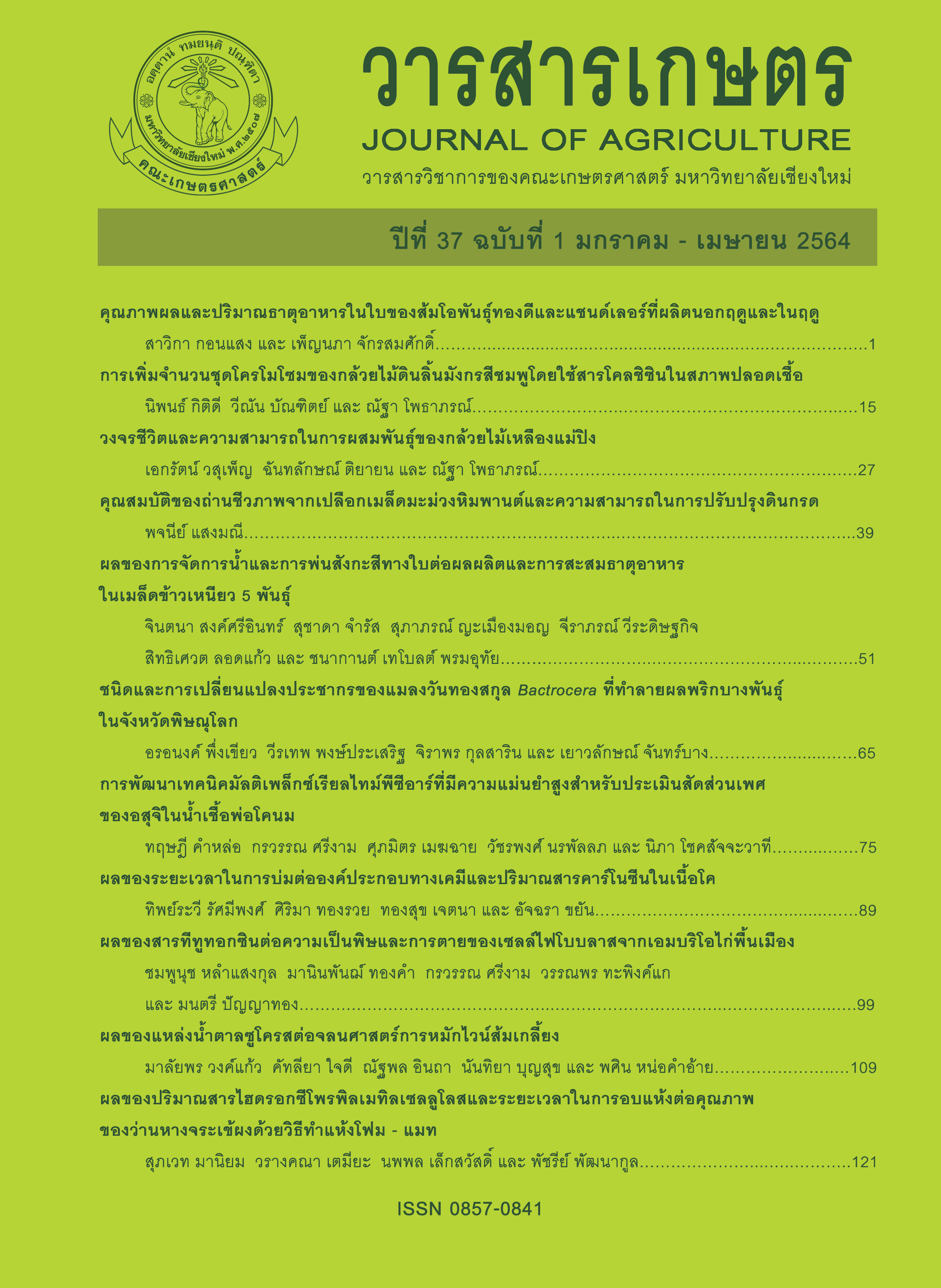การพัฒนาเทคนิคมัลติเพล็กซ์เรียลไทม์พีซีอาร์ที่มีความแม่นยำสูงสำหรับประเมินสัดส่วนเพศของอสุจิในน้ำเชื้อพ่อโคนม
Main Article Content
บทคัดย่อ
การประเมินสัดส่วนเพศของอสุจิด้วยเทคนิคพีซีอาร์เป็นวิธีที่นิยมใช้อย่างกว้างขวางในการประเมินความบริสุทธิ์ของสัดส่วนอสุจิ X และอสุจิ Y ในน้ำเชื้อพ่อโคที่ผ่านกระบวนการคัดแยกเพศ การศึกษานี้มีวัตถุประสงค์เพื่อพัฒนาวิธีการประมาณอัตราส่วนเพศของอสุจิ โดยใช้ปฏิกิริยาลูกโซ่โพลีเมอเรสแบบมัลติเพล็กซ์เรียลไทม์ (multiplex real - time PCR) ทำการเพิ่มปริมาณดีเอ็นเอเป้าหมายที่สนใจพร้อมกันในหลอดเดียวด้วยชุดไพรเมอร์ที่จำเพาะเจาะจงต่อยีน proteolipid protein (PLP) บนโครโมโซม X และไพรเมอร์ที่จำเพาะเจาะจงต่อยีน sex - determining region Y (SRY) บนโครโมโซม Y แสดงการเพิ่มปริมาณดีเอ็นเอผลลัพธ์เส้นใหม่ด้วยสีฟลูออเรสเซนต์ติดที่โพรบ (Taqman) โดยโพรบของยีน PLP ติดสี HEX และโพรบของยีน SRY ติดสี FAM และใช้ดีเอ็นเออ้างอิงจากเซลล์เม็ดเลือดขาวโคเพศผู้ ซึ่งมีอัตราส่วนของโครโมโซม X และโครโมโซม Y ที่เท่ากัน สร้างเป็นกราฟเส้นตรงมาตรฐาน จากการศึกษาได้กราฟเส้นตรงมาตรฐานของยีน PLP และ ยีน SRY แสดงสมการเชิงเส้นสองสมการสำหรับคำนวณอัตราส่วนอสุจิ X และอสุจิ Y โดยมีค่าความชันเฉลี่ยของกราฟเส้นตรงทั้งสองเท่ากับ - 3.330 แสดงถึงปฏิกิริยาที่มีประสิทธิภาพสูงในการสร้างดีเอ็นเอเส้นใหม่ (ร้อยละ 99.66) ทดสอบความแม่นยำของการประเมินสัดส่วนเพศอสุจิด้วยเทคนิค multiplex real - time PCR ในตัวอย่างน้ำเชื้อพ่อโคนมจำนวน 9 ตัวอย่าง ได้แก่ น้ำเชื้อคัดเพศผู้มีอสุจิ Y ร้อยละ 90 ตัวอย่างน้ำเชื้อที่มีอสุจิ Y สัดส่วนร้อยละ 80, 70, 60, 50, 40, 30, 20 และตัวอย่างน้ำเชื้อคัดเพศเมียมีอสุจิ Y ร้อยละ 10 ตามลำดับ เปรียบเทียบผลการคำนวณสัดส่วนอสุจิด้วยเทคนิคมาตรฐานสองเทคนิคคือ ซิงเกิลเพล็กซ์เรียลไทม์พีซีอาร์แบบแยกหลอด (singleplex real - time PCR) และเทคนิคมัลติเพล็กซ์ดรอปเล็ตดิจิทัลพีซีอาร์ (multiplex droplet digital PCR) ซึ่งแต่ละตัวอย่างถูกทดสอบจำนวนสามซ้ำ แสดงผลการคำนวณเป็นร้อยละของอสุจิ Y จากการเปรียบเทียบผลการประมาณอัตราส่วนเพศอสุจิ พบว่า ทั้งสามเทคนิคสามารถคำนวณสัดส่วนเพศได้ถูกต้องใกล้เคียงกับตัวอย่างที่ทราบค่าที่เตรียมไว้และได้ผลการคำนวณสัดส่วนของอสุจิ Y ใกล้เคียงกันทั้งหมด โดยไม่มีความแตกต่างทางสถิติ ดังนั้น เทคนิค multiplex real - time PCR ที่ได้พัฒนาขึ้นในการศึกษานี้จึงคุ้มค่า ประหยัดเวลา และให้ผลการประเมินสัดส่วนเพศที่แม่นยำ
Article Details
เอกสารอ้างอิง
Amadesi, A., A. Frana, L.M. Gandini, V. Bornaghi, K. Parati, G. Bongioni, R. Puglisi and A. Galli. 2015. Comparison between primary sex ratio in spermatozoa of bulls and secondary sex ratio in the deriving offspring. Theriogenology 83(2): 199-205.
Blecher, S.R., R. Howie, S. Li, J. Detmar and L.M. Blahut. 1999. A new approach to immunological sexing of sperm. Theriogenology 52(8): 1309-1321.
Claassens, O.E., C.J.J. Oosthuizen, J. Brusnicky, D.R. Franken and T.F. Kruger. 1995. Fluorescent in situ hybridization evaluation of human Y-bearing spermatozoa separated by albumin density gradients. Fertility and Sterility 63(2): 417-418.
Colley, A., M. Buhr and S.P. Golovan. 2008. Single bovine sperm sex typing by amelogenin nested PCR. Theriogenology 70(6): 978-983.
Cray, N., M. Wagner, J. Hauer and E. Roti Roti. 2020. Technical note: Droplet digital PCR precisely and accurately quantifies sex skew in bovine semen. Journal of Dairy Science 103(7): 6698-6705.
Dumrongsri, S., T. Khamlor, P. Pongpiachan and K. Sringarm. 2016. Determination of male-specific gene expression of White Lamphun cattle semen treated by monoclonal antibodies. Indian Journal of Animal Sciences 86(8): 878-882.
Ericsson, R.J., C.N. Langevin and M. Nishino. 1973. Isolation of fractions rich in human Y sperm. Nature 246(5433): 421-424.
Garner, D.L., B.L. Gledhill, D. Pinkel, S. Lake, D. Stephenson, M.A. van Dilla and L.A. Johnson. 1983. Quantification of the X- and Y-chromosome-bearing spermatozoa of domestic animals by flow cytometry. Biology of Reproduction 28(2): 312-321.
Goldberg, E.H., E.A. Boyse, D. Bennett, M. Scheid and E.A. Carswell. 1971. Serological demonstration of H-Y (male) antigen on mouse sperm. Nature 232(5311): 478-480.
Gomez, K.A. and A.A. Gomez. 1984. Statistical Procedures for Agricultural Research. 2nd ed. John Wiley and Sons, NewYork. 680 p.
Habermann, F.A., A. Winter, I. Olsaker, P. Reichert and R. Fries. 2005. Validation of sperm sexing in the cattle (Bos taurus) by dual colour fluorescence in situ hybridization. Journal of Animal Breeding and Genetics 122(s1): 22-27.
Husna, A.U., M.A. Awan, A. Mehmood, T. Sultana, Q. Shahzad, M.S. Ansari, B.A. Rakha, S.M. Saqlan Naqvi and S. Akhter. 2017. Sperm sexing in Nili-Ravi buffalo through modified swim up: Validation using SYBR® green real-time PCR. Animal Reproduction Science 182: 69-76.
Iwasaki, S., Y. Shioya, H. Masuda, A. Hanada and T. Nakahara. 1988. Sex ratio of early embryos fertilized in vitro with spermatozoa separated by percoll. Theriogenology 30(6): 1191-1198.
Joerg, H., M. Asai, D. Graphodatskaya, F. Janett and G. Stranzinger. 2004. Validating bovine sexed semen samples using quantitative PCR. Journal of Animal Breeding and Genetics 121(3): 209-215.
Johnson, L.A., J.P. Flook and H.W. Hawk. 1989. Sex preselection in rabbits: Live births from X and Y sperm separated by DNA and cell sorting. Biology of Reproduction 41(2): 199-203.
Khamlor, T., P. Pongpiachan, S. Sangsritavong and N. Chokesajjawatee. 2014. Determination of sperm sex ratio in bovine semen using multiplex real-time polymerase chain reaction. Asian-Australasian Journal of Animal Sciences 27(10): 1411-1416.
Machado, G.M., J.O. Carvalho, E. Siqueira Filho, E.S. Caixeta, M.M. Franco, R. Rumpf and M.A.N. Dode. 2009. Effect of Percoll volume, duration and force of centrifugation, on in vitro production and sex ratio of bovine embryos. Theriogenology 71(8): 1289-1297.
Madrid-Bury, N., R. Fernández, A. Jiménez, S. Pérez-Garnelo, P. Nuno Moreira, B. Pintado, J. de la Fuente and A. Gutiérrez-Adán. 2003. Effect of ejaculate, bull, and a double swim-up sperm processing method on sperm sex ratio. Zygote 11(3): 229-235.
Maleki, A.F., A.H. Moussavi, M.R. Nassiri, M. Tahmoorespur and S.A. Vakili. 2013. Introducing and validation of SYBR green real-time PCR method to determinate sex ratio in bovine semen. Animal Reproduction Science 140(1-2): 1-6.
Maxwell, W.M.C., G. Evans, F.K. Hollinshead, R. Bathgate, S.P. de Graaf, B.M. Eriksson, L. Gillan, K.M. Morton and J.K. O’Brien. 2004. Integration of sperm sexing technology into the ART toolbox. Animal Reproduction Science 82-83: 79-95.
Parati, K., G. Bongioni, R. Aleandri and A. Galli. 2006. Sex ratio determination in bovine semen: A new approach by quantitative real time PCR. Theriogenology 66(9): 2202-2209.
Piumi F., D. Vaiman, E.P. Cribiu, B. Guerin and P. Humblot. 2001. Specific cytogenetic labeling of bovine spermatozoa bearing X or Y chromosomes using fluorescent in situ hybridization (FISH). Genetics Selection Evolution 33(1): 89-98.
Roti Roti, E., N. Cray, M. Wagner and M.R. Botts. 2017. Inventor. Genus PLC (GB), Assignee. Methods and systems for assessing and/or quantifying sperm cell subpopu-lations bearing a specific genetic signature. U.S. Patent No.: US-2019071725-A1. Date of Patent: September 1, 2017.
Svec, D., A. Tichopad, V. Novosadova, M.W. Pfaffl and M. Kubista. 2015. How good is a PCR efficiency estimate: Recommendations for precise and robust qPCR efficiency assessments. Biomolecular Detection and Quantification 3: 9-16.
Welch, G.R., G.C. Waldbieser, R.J. Wall and L.A. Johnson. 1995. Flow cytometric sperm sorting and PCR to confirm separation of X- and Y-chromosome bearing bovine sperm. Animal Biotechnology 6(2): 131-139.
Yan, J., H.L. Feng, Z. Chen, J. Hu, X. Gao and Y. Qin. 2006. Influence of swim-up time on ratio of X- and Y-bearing spermatozoa. European Journal of Obstetrics & Gynecology and Reproductive Biology 129(2): 150-154.


